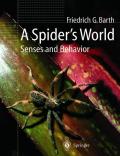
A spider's world: senses and behavior
Barth, Friedrich G.
Biedermann-Thorson, M.A.
Spiders are wonderful creatures. Their varied and complex range of behavior and highly developed sensory systems are excellently adapted to the environmental conditions - as is proven by their evolutionary success. Over 400 million years, spiders have developed their sensory organs to a fascinating technical perfection and complexity.In his intriguing book, Professor Friedrich G. Barth puts this technical perfection into the context of "biology", in which the interaction between environment and sensory organs and the selectivity of the senses as a link between environment and behavior play a major role. INDICE: The General Biology of Cupiennius: How it all Began. The Relatives: Who is Who? The Habitat. Daily Activity Rhythm. No Spider Without Poison.- Sensory Systems: The Special Significance of Mechanical Senses. The Measurementof Strain in the Exoskeleton. The Vibration Sense. Trichobothria - the Measurement of Air Movement. Proprioreception. The Eyes. Chemoreception. Hygro- and Thermoreception: Blumenthal's Tarsal Organ.- The Central Nervous System and Its Peripheral Nerves: The Central Nervous System. The Route for Afferent Inputsto the CNS. The Visual Systems in One Brain. Neurotransmitters and Neuromodulators.- Senses and Behavior: Signposts to the Prey: Substrate Vibrations. Signposts to the Prey: Airflow Stimuli. Courtship and Vibratory Communication. Kinesthetic Orientation. Visual Targets. Raising the Body when Walking over an Obstacle. Locomotion and Leg Reflexes. Swinging to a New Plant: the Dispersal ofthe Spiderlings.-
- ISBN: 978-3-642-07557-5
- Editorial: Springer
- Encuadernacion: Rústica
- Fecha Publicación: 31/03/2012
- Nº Volúmenes: 1
- Idioma: Inglés
